8 B2B Ecommerce Trends to Influence Your 2023 Plans
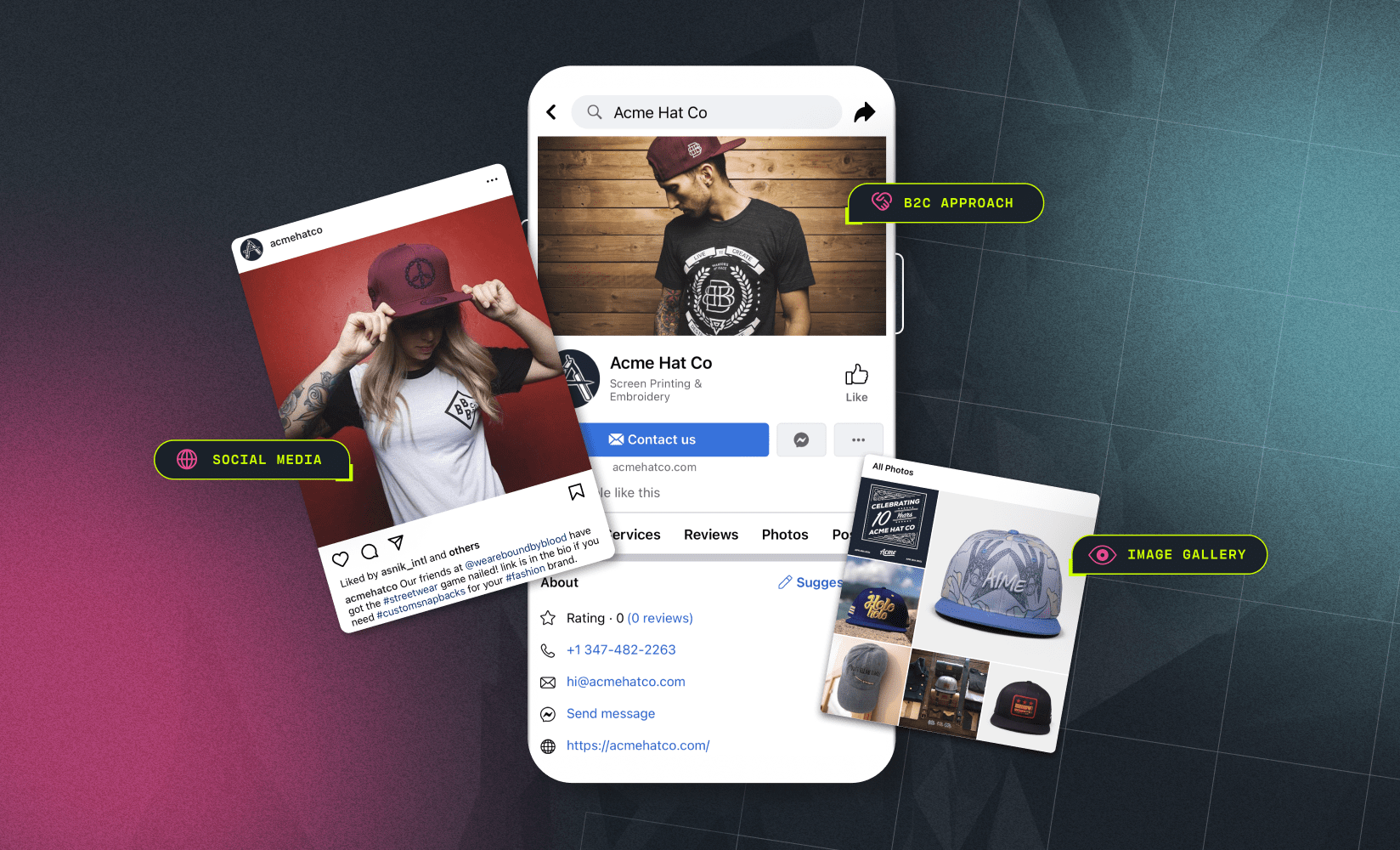
Phew. What a few years it’s been for the B2B ecommerce world. If it feels difficult to keep up with all the global changes—from shopper behavior to supply chain issues—you’re not alone.
To save you some time, we’ve done the research into the top B2B ecommerce trends that are set to shape 2023, along with how to know if a trend is worthwhile for your business as you continue to scale in the B2B space.
In this post, we’ll cover:
#cta-visual-pb#<cta-title>Enable your whole team to start creating<cta-title>Designed for larger ecommerce teams, Shogun Page Builder Advanced gives you 10+ user seats with unique roles and permissions to scale your content creation efforts.Start designing for free
B2B ecommerce statistics + key takeaways
A pandemic, global unrest, ever-evolving consumer behavior, international supply chain issues…there’s a lot going on in the world.
Here’s how the market shook out in 2022 for B2B buyers, with a look at some key B2B ecommerce stats that highlight the current state of this vertical.
B2B ecommerce is thriving
The good news is, despite global unrest, more buyers and sellers than ever are seeing B2B ecommerce as an efficient and needle-moving way to “research and purchase corporate goods and services.”
So much so that total sales for online B2B ecommerce saw a significant increase to the tune of 17.8%, or from $1.39 trillion to $1.63 trillion in 2020.
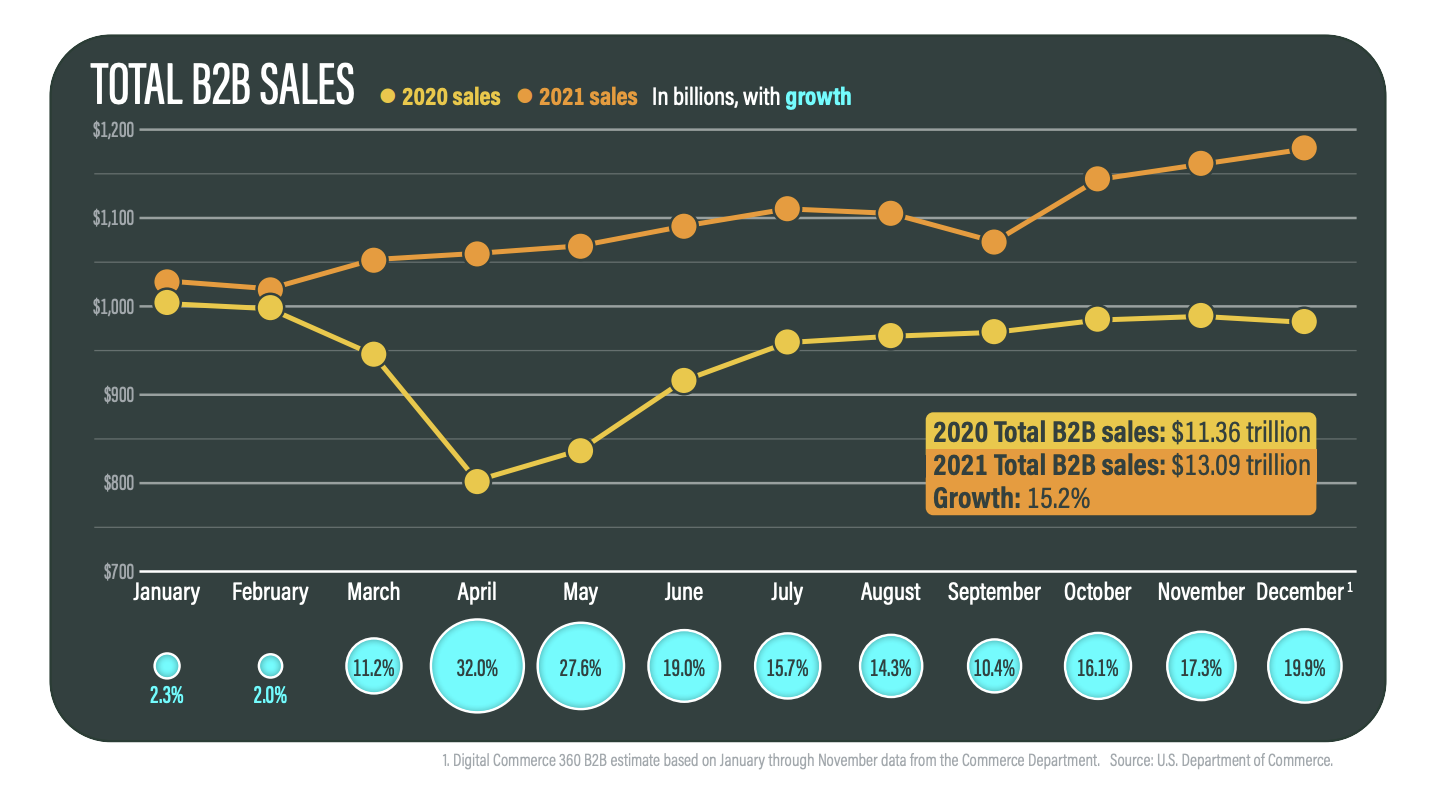
What’s more, 83% of B2B buyers say they prefer ordering or paying through digital commerce. So continuing to invest in crafting your B2B ecommerce experience for this emerging preference is going to be key.
Omnichannel or a ‘hybrid’ approach is the emerging norm for B2B ecommerce
B2B customers have changed the way they shop in a way that’s mirroring B2C habits. Research from BCG found that 60% of B2B customers report that mobile has played a role in a recent purchase. And as a result, B2B ecommerce brands have adjusted their strategy.
Similar to how B2C shoppers seek out more touch points, the average B2B customer now uses 10+ channels—including email, supplier website(s), and search engines—to interact with a company, which is up from just five in 2016.
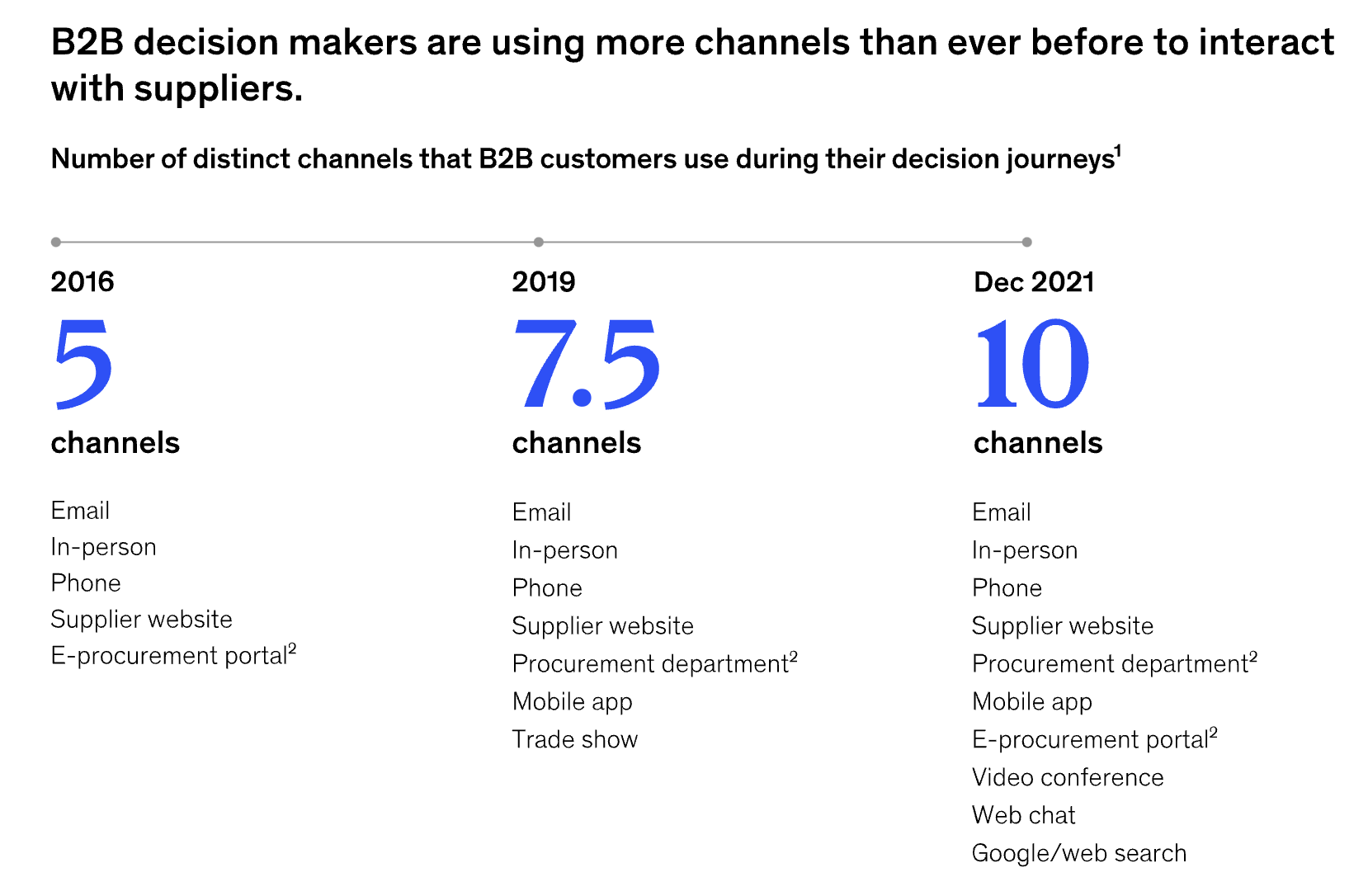
This shift in the B2B buyer journey can be largely attributed to the COVID pandemic, which forced many shoppers to do more buying research online, and B2B brands have had to adopt a more all-encompassing digital presence.
Notably, this shift is sticking. 94% of respondents from a McKinsey survey say they view today’s B2B omnichannel reality (where customers buy in-person, remotely, and online) as effective or more effective than before COVID.
The main challenge here will be for brands to understand which content to supply for buyer evaluation at various times, plus which channels are most effective at each stage of the customer journey. (More on this later!)
B2B buyers are willing to spend more money
In addition to using more channels to engage, B2B consumers are also willing to spend more for the right product or solution.
Now 35% of B2B customers say they’ll spend a whopping $500,000 in a single transaction in 2022, compared to 27% of customers willing to spend that much in 2021. What’s more, 77% of B2B customers will spend about $50,000 minimum.
B2B ecommerce brands should embrace digital transformation and optimize user experience—like B2C
Customer behavior has shifted in the last few years to a focus on mobile and digital experiences, and we see B2B brands slowly realizing the importance of digital transformation aligned to modern shopper expectations.
Today, 37% of B2B leaders say their digital presence is their biggest differentiator, followed by 31% claiming their social media channels to be their main distinguishing factor, which is a great start.
Now, B2B brands who haven’t jumped on refining their digital channels (informed by B2C buyer preferences) need to adjust how they approach ecommerce to keep up.
B2C brands have been doubling down on ecommerce and optimizing customer journeys on their sites for quite some time. The industry has seen steady growth over the past couple of years and counting aligned to this constant refinement:
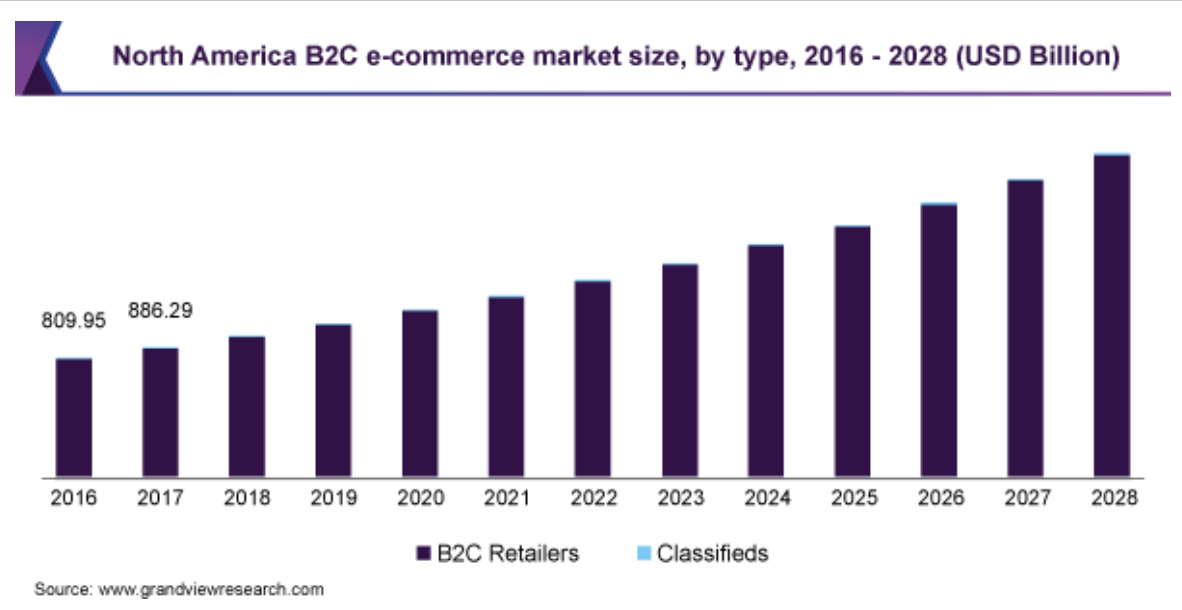
But it’s time B2B brands embrace the same ownership of the ecommerce channel or the experimentation with site design and UX.
Gartner says it best:
“B2B sales channels need to match the seamless, easy and informative standard of B2C digital platforms. Such transformative change takes time, but it is beginning to happen. For example, complex interactions that traditionally required in-person site visits, such as commercial real estate transactions, are moving into virtual reality.”
Some brands, like ACME, for example, are already thinking like a B2C brand when it comes to their website and how it’s crafted. This B2B brand’s ecommerce experience is similar to what one would see in B2C—it includes dynamic UX features like fluid scrolling and feels especially polished vs. industrial or straightforward.
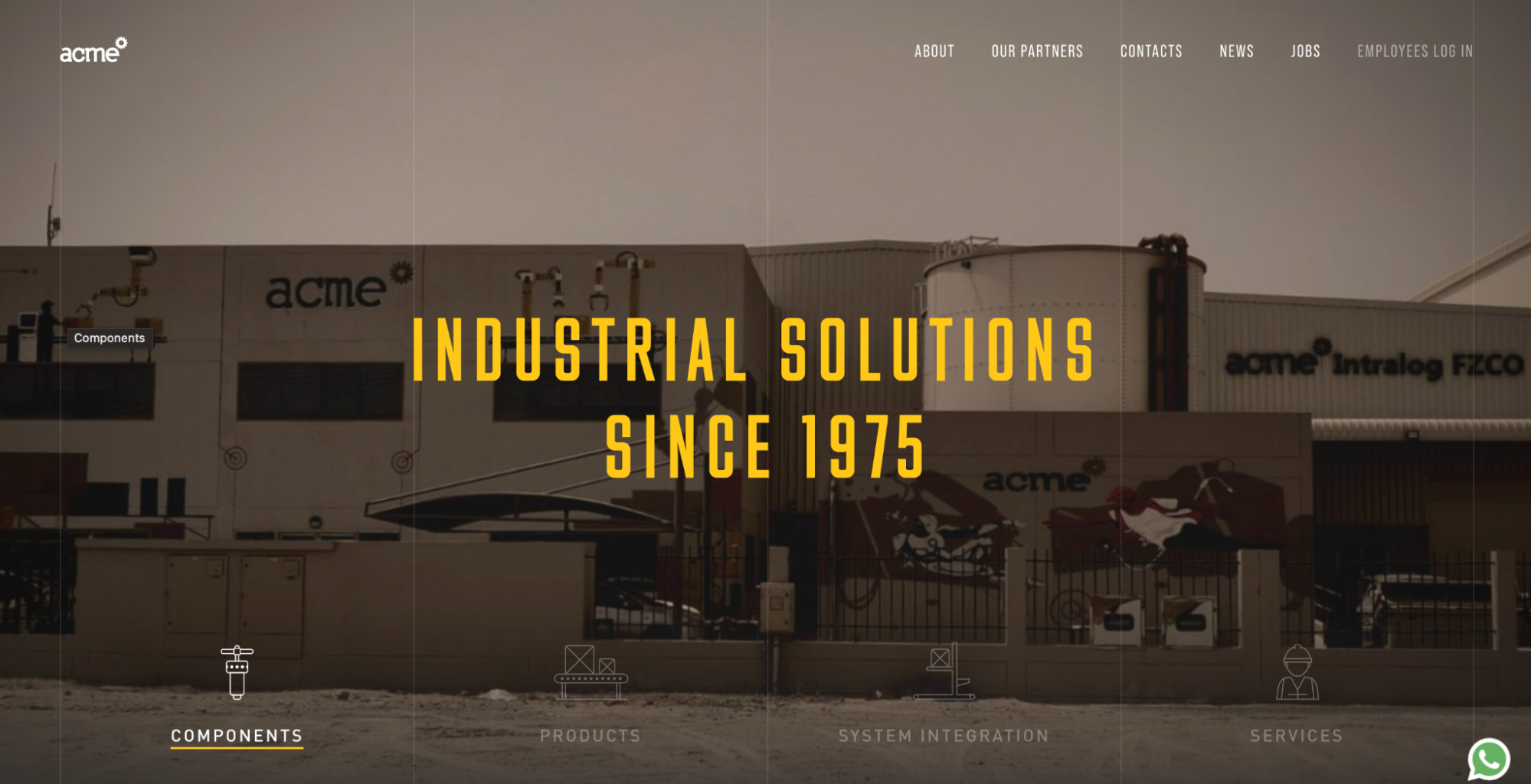

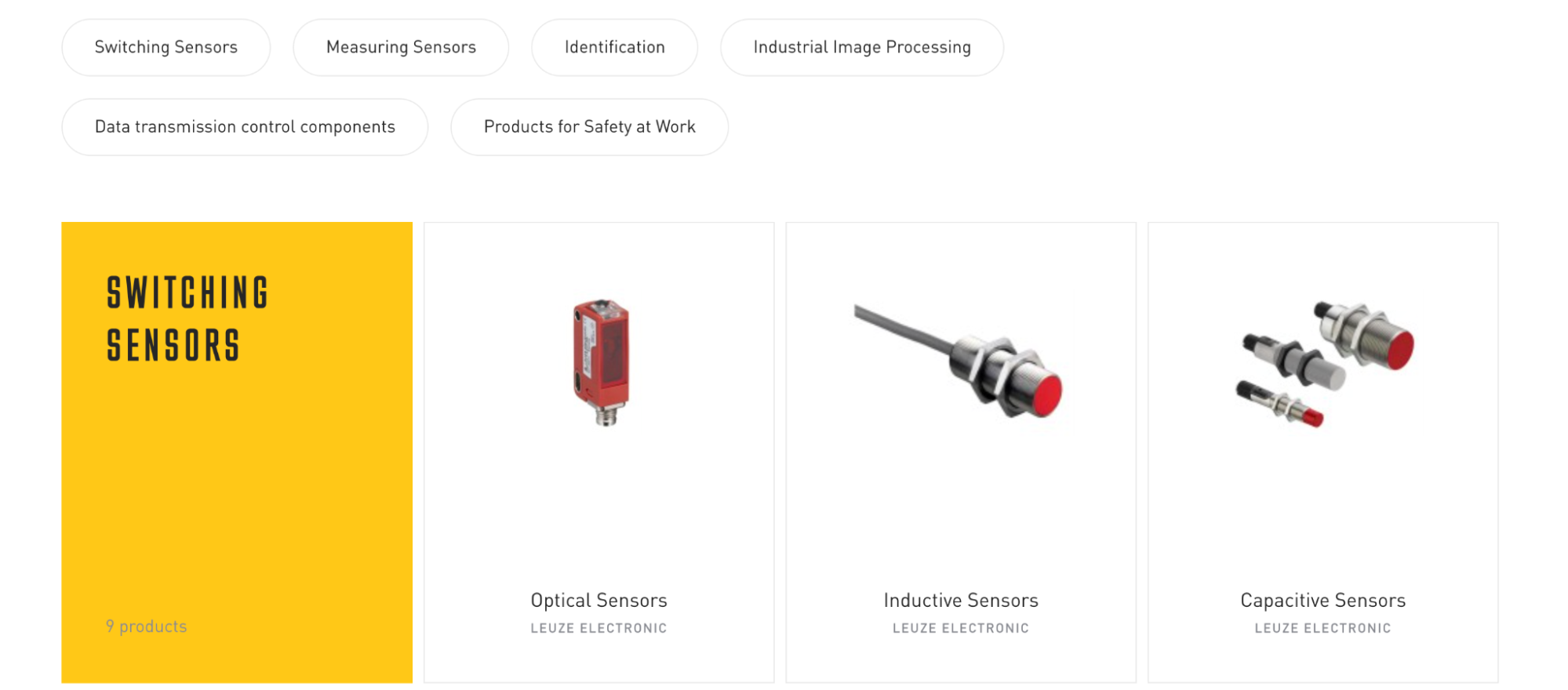
Overall, B2B ecommerce brands who can elevate their ecommerce experiences to match expectations set in B2C shopping will ultimately win.
8 Critical B2B ecommerce trends and how to apply them
As far as we can tell, things are only picking up for B2B ecommerce brands, but it can be tricky to know which trends you should jump on now—while doing it as fast as you can, no less.
Let’s look at the top B2B ecommerce trends to pay attention to and how to tailor each to your brand, customers, and goals.
1. Prioritizing speedier delivery and fulfillment 🏎️
If you’ve purchased anything online in the last few months, you know how the supply chain has been impacted by COVID. 72% of companies reported that pandemic-related supply chain disruptions hurt their business.
However, things are still taking time to bounce back. While the cost of China-US shipping has come down from historical averages in 2021, it’s still much pricier than historical averages.
Despite this, customers still expect a quick turnaround for delivery and fulfillment—faster than ever before. 41% of shoppers expect to receive their online purchase in less than 24 hours.
Companies like ShipBob and other 3PL logistics solutions are helping brands accelerate their fulfillment and delivery times. If you haven’t already, selecting a 3PL company to partner with in 2023 can help you minimize your delivery times and alleviate warehouse space issues.
How to implement
If your brand has experienced delays with shipping, fulfillment, or other supply chain problems this year, it’s worth looking into 3PL partners or evaluating the ones you’re currently working with for effectiveness or improvements.
Importantly, there are three types of 3PL partners you can choose to work with:
- Distribution: These partners provide warehousing and distribution for your products. This option is great for small or medium-sized B2B ecommerce brands looking to grow into different channels and keep a 1-2 day shipping schedule.
- Financial and information: For larger brands with larger volumes of orders, select a 3PL partner with experience with global supply chains. These folks can offer advice on how to best approach your fulfillment process to help you adapt to the changing tides of the industry.
- Transportation: If you need improved transportation for your fulfillment arm, consider a specialized 3PL provider. Often, transportation partners can offer warehousing solutions as well if that’s of interest.
Improving your shipping and fulfillment operations is always a smart priority, and you may choose to execute with a few different types of 3PL partners as you scale or use a combination of different types of 3PL partners for various expertise. Not only does it make for a better customer experience, but it increases the likelihood of a repeat purchase.
2. Highly personalized ecommerce experiences ⭐
Prioritizing personalized shopping experiences is now standard practice for ecommerce brands of all niches—including B2B—more so than a trend. Customers want ecommerce experiences that feel uniquely tailored to their needs or preferences.
With 90% of marketers claiming ecommerce personalization has boosted their revenue, it’s clear that it’s not going away anytime soon. Plus, 80% of customers are more likely to buy from a company that provides a tailored shopping experience over a generic one.
Features that take your B2B ecommerce store to the next level—like recommended products based on browsing history, unique offers for new customers, or even something more technical like AR—can have a significant impact.
How to implement
Think about your customer journey and what touchpoints you could strengthen via personalization for the buyer.
For example, if you offer a pro/contractor program (or similar) as part of how you sell B2B (like Home Depot Pro), think about what features or distinct information separate from your B2C site could encourage B2B customers to convert.
Notably, Home Depot Pro (for contractors) is set up very similarly to their B2C site but includes details this audience segment needs to know to purchase—like very specific product information and specs, additional resources, and wholesale discounts.
Consider: are there avenues of your ecommerce experience you can silo or create with specific details and features intended for B2B shoppers?

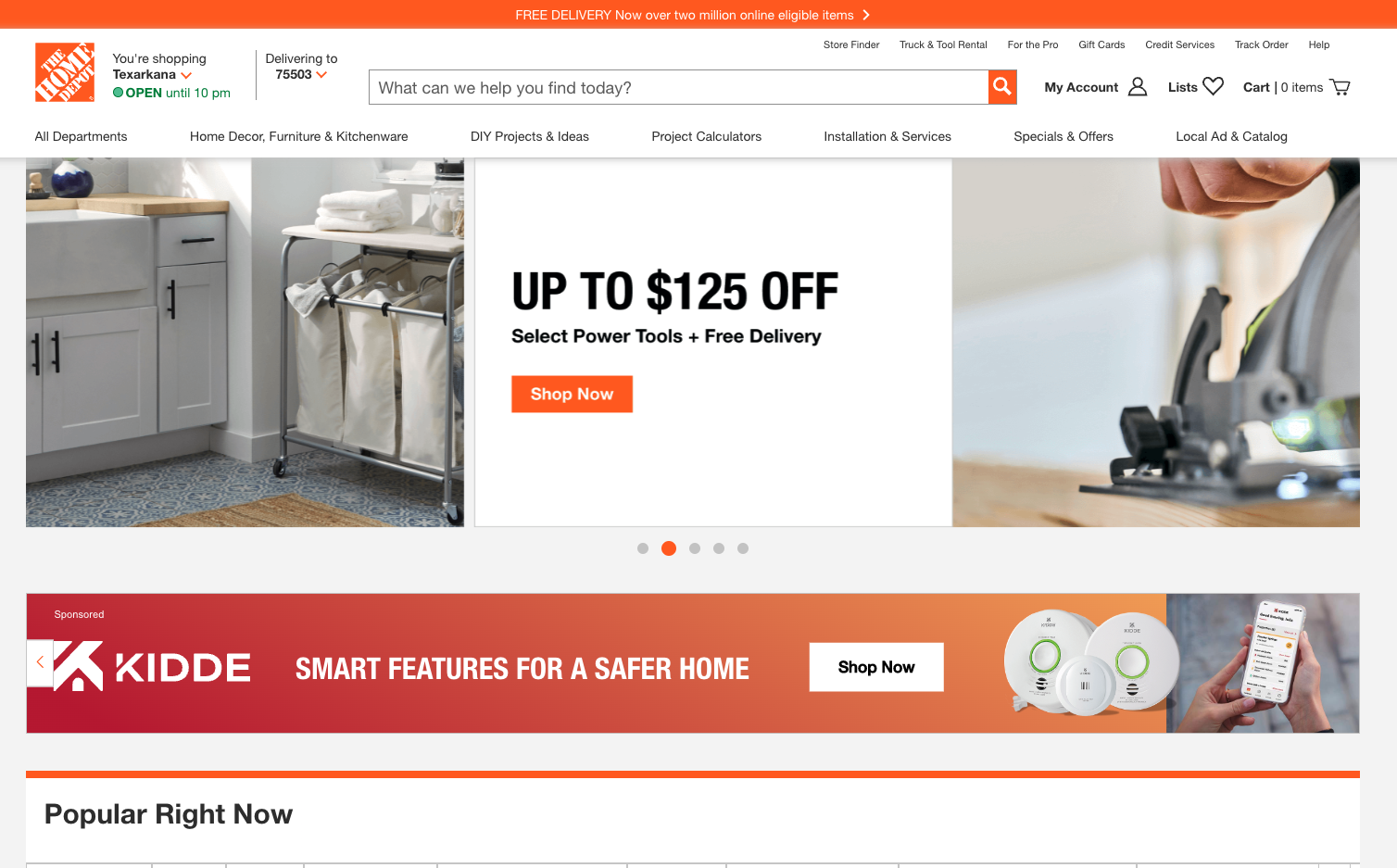
This may seem simple, but a contractor-focused experience not only positions Home Depot Pro as a reliable source of information for a specific segment, but it will likely help minimize returns if shoppers get the products they need on the first go.
3. Doubling down on an intentional social media presence 🔔
Social media isn’t just for B2C brands! Yes, even B2B ecommerce brands can find success on platforms like TikTok, which are largely used by B2C brands to market their products.
Gartner found that 46% of B2B buyers turn to social media at the start of their purchase journey. But despite this, 85% of businesses aren’t yet leveraging social media.
So, if your B2B brand isn’t giving much thought to social media strategy for 2023 and beyond, you may want to reconsider.
Social media is a great place to showcase existing product lines and release new ones, highlight customer stories, and more. It’s a chance to be creative and highlight the humanness of your brand (as B2B shoppers are still humans, too!).
Take Acme Hat Co., for example. The custom B2B hat brand (selling custom hat design and manufacturing to companies big and small) regularly takes to social to convey their personality and fundraising efforts, like with this Facebook post:
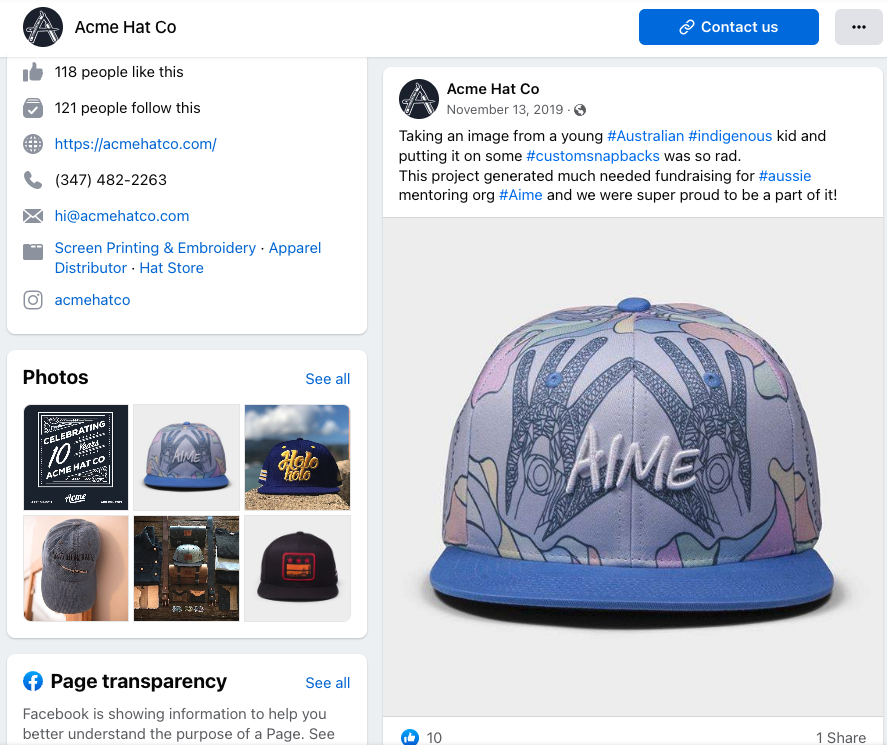
How to implement
Audit your social media channels and determine which may be the most successful for reaching a B2B audience (you might be surprised!). Then decide which creative angle might draw in your buyer and which products—or behind-the-scenes stories—you might begin to tell. You may sell robotics to businesses, for example, but it’s all just people-to-people, after all.
#cta-mini-pb#Ready to get started on TikTok? Read our Guide to TikTok: How 11 DTC Brands Find New Customers
4. Optimize for mobile-first shopping 📱
Mobile commerce isn’t new by any means, but it’s seen continued growth over the years—especially since 2020. The total m-commerce retail sales are expected to reach $431 billion in 2022 and reach $710 billion by 2025 🤯.
Buyers love to shop on mobile devices—whether they’re searching for a new business solution or pair of shoes.
In B2B, doubling down on your mobile ecommerce experience looks like creating a mobile-first site, introducing features for faster shopping like one-click checkout, or even investing in a progressive web app (PWA) to elevate your shopping experience.
How to implement
Mobile commerce isn’t going away anytime soon. Your customers are on the go, and your site needs to fit into wherever they are and however they’re shopping.
QA your site for mobile and ensure it’s responsive and optimized correctly. Google offers several tools to test the health of your site, like Mobile-Friendly Test and PageSpeed Insights, as you optimize so you can craft the best mobile experience possible.
Related: Measuring PWA Performance: What to Know About Data Integrity and ROI
5. Improving legacy systems and investing in headless commerce 💾
B2C brands always seem to be on the cutting edge with the underlying tech that powers their sites—like Apple’s always-impressive online shopping experience:
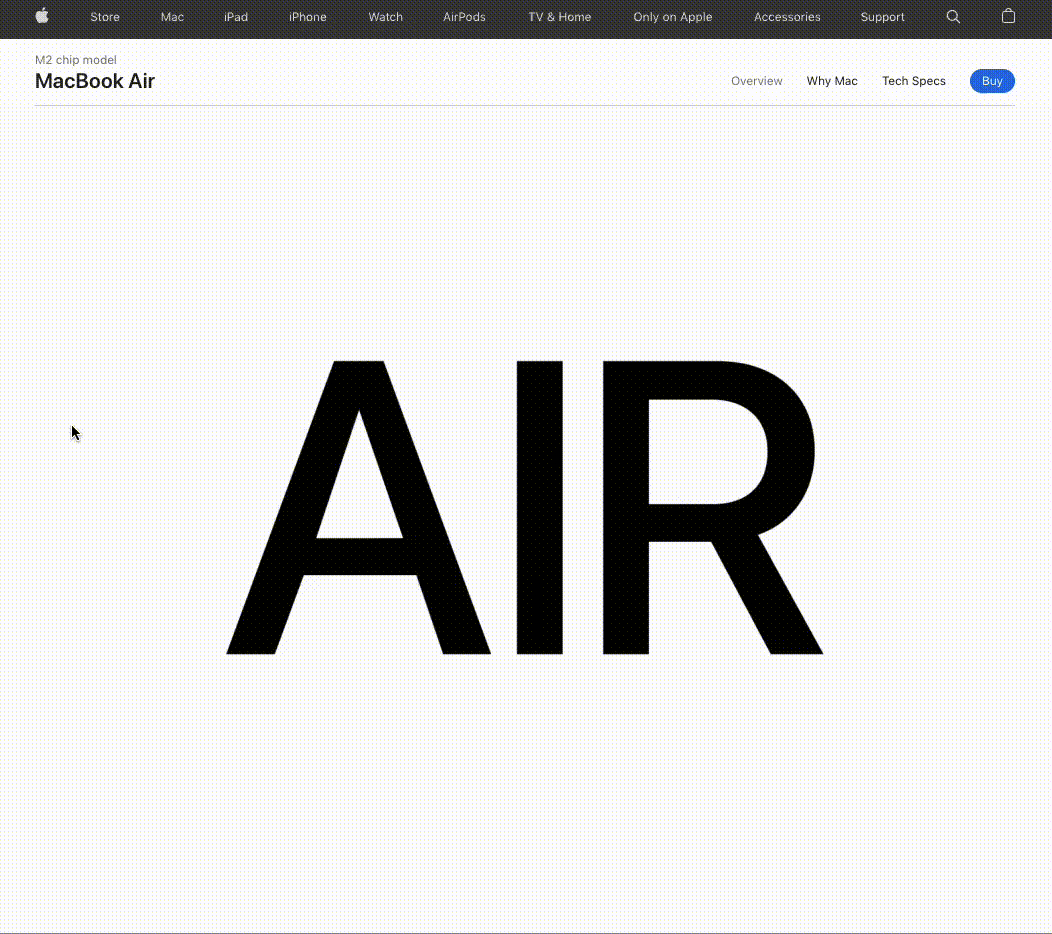
In contrast, many B2B ecommerce brands tend to only upgrade their backend tech powering their ecommerce experience when it’s absolutely necessary.
41% of B2B ecommerce brands say that creating a more elevated online shopping experience to meet the needs of customers is their top challenge, followed closely by 36% who say “upgrading legacy systems” is their biggest mountain to climb.
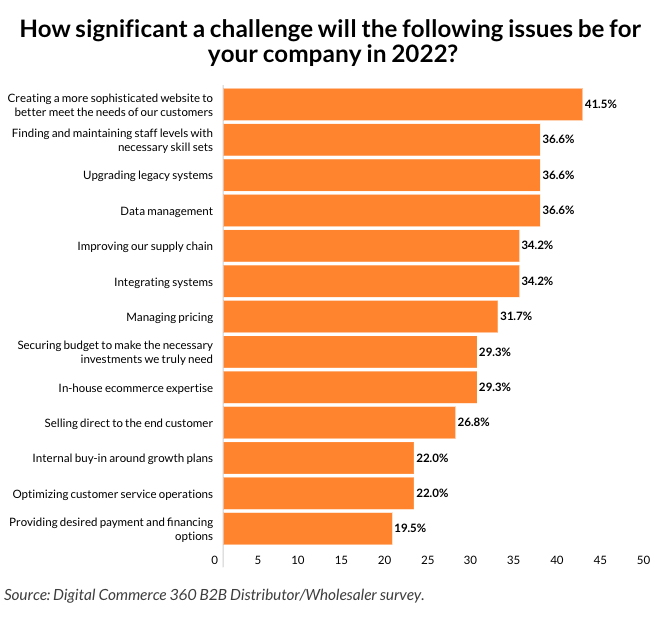
Despite some technical debt or legacy systems, B2B thinking is shifting to a partnership point of view rather than a “we’ve always had this tech, so we should stick with it” one.
In starting to evaluate their legacy systems and tech, some B2B ecommerce brands are feeling limited by monolithic ecommerce platforms—both from a performance and design lens.
For so long, the bandaid fix for many scaling brands has been to roll out a new theme or even replatform backend ecommerce platforms altogether.
But often, that just soothes the symptoms. It doesn’t cure the problem.
Solutions like headless commerce (a la Shopify Hydrogen or similar) can allow brands to build snappier ecommerce experiences at a cost. For brands that go with Shopify Hydrogen, Shogun Page Builder is an excellent choice to visually build every headless store page.
How to implement
One of the best ways to implement a headless ecommerce store for Shopify stores is to use Hydrogen. While on its own, it is a development-heavy avenue, brands can use Page Builder Advanced to drag and drop their store together without coding.
6. Adopting an omnichannel strategy 🛍️
“Be where your customers are” is still sound advice for B2B ecommerce brands as we move into 2023.
Very rarely do customers land on a site and immediately make a purchase. Usually, customers engage with you across different channels before buying. As we covered earlier, the average B2B customer now uses 10+ channels informing a purchase (up from only 6 a few years ago).

So, it’s all the more important to prioritize each customer touchpoint. Implementing an omnichannel marketing strategy allows you to connect with your customers in spaces they’re already familiar with using.
Related:
Omnichannel Fulfillment: How to Deliver Your Best Across Every Channel
Omnichannel Commerce: How to Deliver Unified Experiences & Sell Everywhere
Omnichannel Retail Strategy in 2022: How to Scale Past Pure Play
How to implement
First, identify your top channels—or the channels your customers use. It can be helpful to ask past customers about their approach to buying to narrow this list down, like:
- Where do you start your product search?
- Which social media channels do you actively use?
- What type of content do you engage with the most?
Then, once you have your channels listed and how your customers move through the purchase journey, you can get clear on the type of information you want to push on each channel, and how this can be made to feel especially seamless (from messaging to engagement with your brand).
For example, if you want to invest in TikTok or YouTube to seed a given message for your B2B brand, you could create a weekly video series that highlights different features of your product, answers customer questions, or promotes a new offering.
You can gain inspo for B2B with B2C content. Check out what Dermalogica does here with their grant program announcement, for example:

7. Investing in ecommerce marketplaces 🛒
In the same vein as adopting omnichannel, more B2B ecommerce brands are expanding their reach by investing in ecommerce marketplaces.
This channel offers B2B brands several opportunities to reach new audiences, experiment with third-party marketing, and appear where your ideal customers are.
The numbers don’t lie: Collective sales from B2B ecommerce marketplaces grew 130% YOY in 2021 to $56 billion.
Take home fragrance company, P.F. Candle Co., for example. While the brand has a strong B2C presence, they also use wholesale and marketplace channels like Faire to get their products into physical stores.

Retailers can shop their marketplace page at a discounted price, and P.F. Candle Co. products will appear in other boutiques and retail shops across the world. By selling through a marketplace, P.F. Candle Co. expands their audience and revenue streams. A win-win!
How to implement
Consider which marketplaces make sense for the B2B arm of your brand and how you should show up.
Once you’ve identified the marketplace(s) that are a good fit for your B2B ecommerce brand, make sure there’s an appropriate product category that aligns with what you sell.
Also, consider how many products are currently listed under that category. Don’t be deterred from marketplaces with a high volume of a certain product. While it likely means higher competition, it confirms there’s a demand for that product type in that marketplace.
8. Leaning into sustainability ♻️
With 45% of customers saying they’re interested in buying from brands with eco-friendly or environmentally responsible ethics, leaning into sustainability is great for business and Mother Nature.
How to implement
Audit your existing business practices—like shipping, fulfillment, packaging, and more. Are they sustainable for the environment?
Packaging is a great place to start if you aren’t sure where to begin. Here are a few great swaps you can make today:
- Biodegradable packing peanuts vs. styrofoam
- Recycled cardboard and paper products
- Packaging that can be used twice (once for shipping and once for returns)
Making one small sustainable change can have a ripple effect on your business and how customers see you for the better.
B2B ecommerce FAQs
What is B2B ecommerce?
B2B ecommerce is the buying, selling, marketing, and distribution of goods or services from one business to another through online channels—like a website or digital portal.
How do I start a B2B ecommerce company?
Looking to expand your existing B2C brand into B2B ecommerce? Here’s how in a few simple steps:
1. Determine there’s a market fit for your products in the B2B space.
2. Design a B2B portal that speaks to B2B businesses yet still feels part of your overall brand. Think about including features B2B customers would find helpful, like in-depth product specs or a “see it in your space” feature that adds context and eliminates friction.
3. Research the tech needed to bring your design to life depending on the site experience you want to offer, like personalization tools, large visuals, or a fast shopping experience.
4. Build and link your B2B portal to your existing .com (similar to what Home Depot does, for example), accessible to only those part of your B2B program/offering.
5. Consider which channels to market through based on your target audience’s behavior/preferences.
What is the difference between B2B ecommerce and B2C ecommerce?
B2B ecommerce is one business selling goods and services to another business. B2C ecommerce is one business selling goods and services to an individual.
The future of B2B ecommerce is encouraging 🔮
There’s a lot to consider for B2B ecommerce brands.
Our advice: narrow your focus to only a few trends that will move the needle for your business next year and beyond. If you’re trying to boost conversions, consider an omnichannel strategy. If you want to engage with your audience in different ways to learn even more about their motivations, look into strengthening your social media presence and garnering fast feedback.
#cta-visual-pb#<cta-title>Enable your whole team to start creating<cta-title>Designed for larger ecommerce teams, Shogun Page Builder Advanced gives you 10+ user seats with unique roles and permissions to scale your content creation efforts.Start building for free

Kaitlyn Ambrose
Kaitlyn works on all things content at Shogun. ⚡



